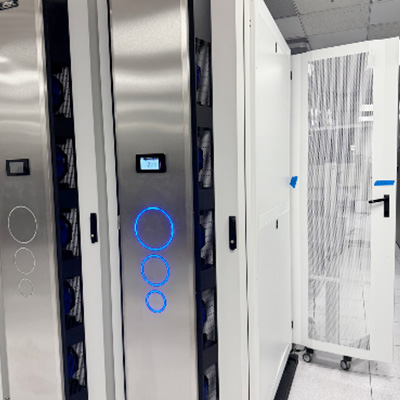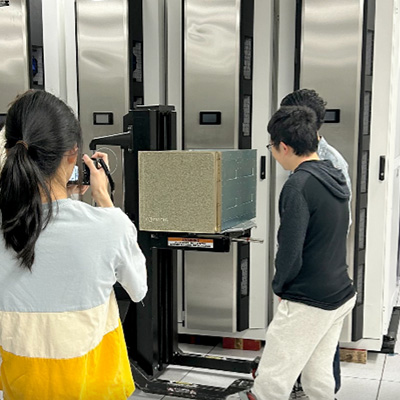UC San Diego Packs a Punch of AI Research Power with a Gift from NVIDIA
The new School of Computing, Information and Data Sciences (SCIDS) offers researchers access to one of the most powerful AI systems available
Story by:
Published Date
Article Content
The MLSys Group and the Hao AI Lab, led by Hao Zhang, an assistant professor at the Halıcıoğlu Data Science Institute (HDSI) within SCIDS at the University of California San Diego, are on a mission to open up access to large machine learning (ML) models, algorithms, evaluations and their underlying systems.
Over a decade ago, as a graduate student, Zhang applied for and received a GPU donation from NVIDIA that set him on a path to building his research in the emerging area of AI. Today, Zhang and his lab are the beneficiaries of a gift from NVIDIA — a DGX B200 system — the world’s most advanced platform for AI computing — in recognition of Zhang and his team’s ML and systems research.

“I am genuinely honored and humbled by this gesture,” said Zhang, who also is affiliated with the Computer Science and Engineering Department in the Jacobs School of Engineering. “This generous gift from NVIDIA is a recognition of our contributions in research and open source ecosystems, but also of the growing visibility and influence of the broader SCIDS ecosystem in advancing the future of computing and fostering a new generation of researchers and developers working with cutting-edge AI tools.”
The new system at UC San Diego is expected to accelerate new discoveries in AI/ML system design, model efficiency and applications such as healthcare, robotics and education. It will support new research papers, student-led projects and potential collaborations across university departments.
“NVIDIA’s gift of the DGX B200 system provides our researchers and students with hands-on experience and real-world infrastructure that directly contributes to us training the best talent. NVIDIA’s contributions in spotting and encouraging such talent from the early stages of their research career are noteworthy,” said SCIDS Interim Dean Rajesh K. Gupta.
Technical Features of DGX B200
Zhang described the DGX B200 as one of the most powerful AI systems available today. The San Diego Supercomputer Center (SDSC), also part of SCIDS, has installed the new system in one of its data center racks. The system’s key traits include:
- Extreme Speed: DGX B200 offers one of the fastest AI computing environments in the world.
- Large Memory: DGX B200 can hold massive models in memory, which means better results with less waiting.
- AI-Ready Design: DGX B200 is built from the ground up to handle the latest AI research — from large language models (LLMs) to diffusion models.
- Plug-and-Play for Researchers: With built-in software tools and optimizations, researchers can focus more on ideas, less on setup.
At a high level, DGX B200 uses the powerful NVIDIA Blackwell accelerated computing architecture to run thousands of computations in parallel. These GPUs are especially well-suited for training and running AI models — tasks that require analyzing large amounts of data, spotting patterns and making predictions. DGX B200 links multiple GPUs together in a highly efficient way, creating a platform that can train and serve large models like ChatGPT much faster than traditional supercomputers.
Zhang further explained that DGX B200 is designed to power cutting-edge research in ML, LLMs and scientific computing. At UC San Diego, it will be used by faculty and students to accelerate research in areas like AI systems, high-performance computing and foundational models — enabling new collaborations among researchers.
“Leading companies like OpenAI, Meta, and xAI rely on tens of thousands of such GPUs to train models like Llama and ChatGPT. DGX B200 systems bring that class of compute to our university,” Zhang said. “This gift puts UC San Diego on the map as a place where world-class AI research can happen — not just in theory, but in practice.”
Benefits for Faculty and Student Researchers

The new gift will directly benefit researchers at the university who are working on AI, systems, data science and computational science. It will also support student researchers, including Ph.D. students and postdocs, who now have access to AI infrastructure.
“In the long run, breakthroughs made using this machine — whether in improving AI efficiency, enabling faster medical discoveries or training next-generation models — will spread beyond the university and benefit the broader public,” said SDSC Director Frank Würthwein.
“It is immensely satisfying to see the talent we have recruited over the years working together. The Hao AI Lab and MLSys community are a highlight of the notable presence we have created in data science for UC San Diego. We are sincerely thankful to NVIDIA for their contribution to building an excellent talent pool in the U.S.,” said Gupta.
Learn more about research and education at UC San Diego in: Artificial Intelligence
Share This:
Stay in the Know
Keep up with all the latest from UC San Diego. Subscribe to the newsletter today.




